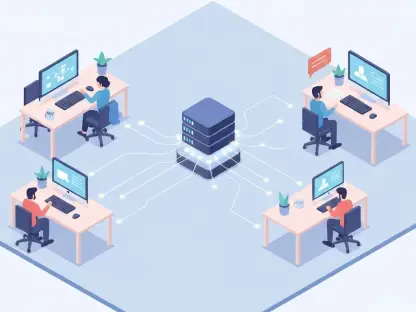Imagine a world where software development not only fuels business growth but also slashes costs dramatically through cutting-edge technology. A recent global survey of over 2,700 C-level executives reveals that artificial intelligence (AI) is transforming the industry, delivering an average annual saving of $28,249 per developer. This staggering figure is paired with a 48% boost in productivity, showcasing how AI is reshaping the economic landscape of software creation. Beyond mere automation, AI is proving to be a powerful engine for innovation, with over half of the surveyed leaders linking recent business expansion to advancements in this field. This paints a compelling picture of a sector on the cusp of a technological revolution, where efficiency and growth go hand in hand, prompting a deeper exploration of how AI is redefining priorities, presenting challenges, and shaping future expectations.
Economic and Strategic Impacts of AI
Unleashing Financial Gains Through AI Efficiency
The financial benefits of AI in software development are nothing short of transformative. Organizations are reaping substantial savings, with each developer contributing to an average cost reduction that significantly impacts the bottom line. This efficiency stems from AI’s ability to streamline repetitive tasks, allowing teams to focus on high-value work. Moreover, a notable 58% of executives report business growth directly tied to software innovation, which has led to an estimated 44% increase in revenue for many firms. This underscores a broader recognition that AI is not just a tool for cutting costs but a strategic asset that drives competitive advantage. The data paints a clear picture: embracing AI translates into tangible economic success, positioning companies to outpace rivals in a fast-evolving market. As these savings and growth metrics become more widely understood, they are likely to spur even greater investment in AI-driven solutions across the industry.
Elevating Software Innovation to Boardroom Priority
Beyond financial metrics, AI is fundamentally altering strategic priorities at the highest levels of business. An overwhelming 91% of surveyed leaders now view software innovation as a core focus, with many organizations ready to dedicate over half of their IT budgets to these initiatives. This shift is further evidenced by the adoption of frameworks that tie software outcomes to key business goals, with metrics like growth and problem-solving capabilities taking center stage. Such alignment reflects a profound change in perspective, where software development is no longer a back-office function but a critical driver of overall strategy. With board-level support echoing this sentiment, the integration of AI into these efforts is seen as essential to maintaining relevance in a digital-first world. This strategic pivot ensures that technological advancements are not just tactical but deeply embedded in long-term vision and planning.
Challenges and Future Outlook in AI Adoption
Navigating Security and Governance Hurdles
Despite the enthusiasm for AI’s potential, significant challenges loom large on the horizon. Cybersecurity threats and data privacy concerns rank as top worries for over half of the executives surveyed, with governance issues also weighing heavily on decision-makers. In response, many organizations are taking proactive steps, such as implementing regulatory-aligned measures and developing internal policies to manage AI usage. Third-party audits are also becoming a common practice to ensure compliance and mitigate risks. These efforts highlight a critical balance between innovation and responsibility, as leaders strive to harness AI’s benefits without compromising security. Addressing these hurdles is not merely a technical necessity but a strategic imperative, as trust and safety remain paramount in sustaining the momentum of AI adoption across the sector.
Balancing Human Creativity with AI Capabilities
Looking ahead, the interplay between human talent and AI technology emerges as a defining theme. While 89% of executives anticipate agentic AI becoming the industry standard within the next three years, there is a strong consensus on the enduring value of human input. Creativity and strategic vision are seen as irreplaceable, with nearly all leaders emphasizing the need for a partnership model where workloads are shared evenly between humans and machines. This balanced approach is further supported by a push for retraining programs to equip teams with skills to collaborate with advanced AI tools. The rise of citizen developers using low-code platforms also signals a broader democratization of development, necessitating widespread upskilling. As organizations continue to hire developers to meet growing demand, it is evident that AI serves as a complement to human ingenuity rather than a replacement, shaping a future where collaboration drives innovation.
Preparing for a Transformative Shift
Reflecting on the journey so far, the integration of AI into software development marked a pivotal moment for the industry. It redefined productivity standards, delivering unprecedented savings and fostering growth that reshaped business landscapes. The cautious optimism among leaders was evident as they navigated security challenges with robust governance and prioritized human-AI collaboration through targeted training. Looking to the next steps, organizations must continue investing in skill development to bridge gaps and empower teams to work alongside evolving technologies. Strengthening risk management frameworks will also be crucial to safeguard against potential pitfalls. As the sector stands at this transformative crossroads, a commitment to balancing technological advancements with human oversight will pave the way for sustainable progress, ensuring that the promise of AI is fully realized in the years ahead.









